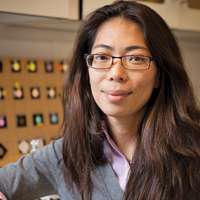While the field of engineering as a whole is largely male-dominated, biomedical engineering (BME) is one area poised to overturn this trend. Women in the United States were awarded only 20% of all engineering B.S. degrees in 2015; in BME, however, 40.9% of the degree recipients were women. This stands in stark contrast to the more traditional fields of mechanical and electrical engineering, where women were awarded just 13.2% and 12.5% of B.S. degrees, respectively. This trend toward more female participation in BME continues at both the M.S. and Ph.D. degree levels. In fact, in 2015, BME had the highest percentage of female engineering M.S. degree recipients in the United States of all engineering disciplines, according to the American Society for Engineering Education (Figure 1).
![Figure 1: The percent of degrees in BME, versus mechanical and electrical engineering, received by women. Data taken from [4].](https://www.embs.org/wp-content/uploads/2017/06/gutierrez01-2750818.png)
Why is BME attracting so many women? More importantly, what can other engineering fields learn from this field to increase participation by women?
The Draw to BME
At its core, BME is an exciting field that integrates medicine and engineering, but what specifically is it about this combination that appeals to women more than other engineering disciplines? One of the most commonly reported theories is that women who enter the field of BME, while passionate about math and science, ultimately want to help improve the lives of others. As Lina Nilsson, innovation director at the Blum Center for Developing Economies at the University of California, Berkeley, wrote in The New York Times in 2015, “Women seem to be drawn to engineering projects that attempt to achieve societal good.” She and her colleagues found that, when universities offer humanitarian-centered opportunities, women are more likely to participate. For example, the D-Lab at MIT (Development Through Discovery, Design, and Dissemination) “focuses on developing ‘technologies that improve the lives of people living in poverty,’” and more than 74% of the students involved are women, according to Nilsson’s essay.

While studies have shown that women are more philanthropic than men, the desire to help others can lead both men and women into many different career paths outside of BME [1]. And Nilsson’s views received strong pushback from some women in engineering, most notably an op-ed in eastern Illinois’s NewsGazette, where Shannon Lybarger, an electrical engineer who has implemented several Leadership in Energy and Environmental Design certified buildings projects, stated, “I like solving practical problems… Don’t belittle women by thinking we can only work in jobs that fill our hearts and souls.” Many believe that categorizing all women in BME as wanting a career that contributes to society may not resonate broadly and may, in fact, downplay women’s intellectual curiosity and technical ability.
Nozomi Nishimura, an assistant professor of BME at Cornell University, believes that the collaborative nature of the field and its relative novelty play a large role (Figure 2, upper right). “The fact that BME is a new field and is inherently multidisciplinary seems to also produce a culture that is more inclusive,” she said. “Biomedical engineers must interface with traditional engineers, biologists, physicians, [and] patients; so I like to think that BME has more of an appreciation of diverse points of view.” The collaborative nature of BME may also play a role because collaborative working styles are more common to women, as demonstrated by studies showing that women generally choose work environments in which success is defined by team versus individual efforts [2].

Another reason women are being drawn to BME is its job security, both in and outside of the field of engineering. According to the U.S. Bureau of Labor Statistics’ Occupational Outlook Handbook, for architecture and engineering occupations, the number of jobs in BME is projected to increase by 23% between 2014 and 2024. Other engineering disciplines, such as mechanical, chemical, and electrical engineering, are expected to grow only 0–5%. With an average salary of US$86,000 in 2015 for a B.S. degree in BME, women looking for an intellectually and financially rewarding career with job security are increasingly turning to BME. When asked why she picked BME, Shubhra Rastogi (Figure 3, right), a sophomore at Drexel University, said that financial security was a factor. “I originally wanted to do biomedical sciences,” she explains, “but, when I heard that BME people do work like brain–machine interfaces or drug delivery systems, that just sounded so much more interesting than just majoring in another science—plus the pay was better as an engineer.”
For those who choose to leave engineering, a background in BME also provides an entrée to other fields, such as medicine, pharmaceuticals, finance, and consulting. Rachel Wang, who has B.S. and M.S. degrees in BME and is an M.B.A. student at the Harvard Business School, says, “I have found that employers in the healthcare industry understand the value of a BME degree. I not only know how to design and engineer a great product, but it also shows my passion for bringing that product to patients” (Figure 4, lower right).

Meanwhile, as BME is considered flexible, lucrative, and human, the engineering disciplines outside BME have traditionally been portrayed as rigid, quantitative fields reserved only for people who love math and science. The inspirational, big-picture aspect of many engineering projects can often get lost in translation. A study by the National Academy of Engineering found that the public image of engineering has been built on the perceived preparation required to enter the engineering field, and it recommends a new effort to include students of all backgrounds by emphasizing the hands-on ways that engineering can make a difference in people’s lives.
Historical Context Plays a Role
According to research by Claudia Goldin, the Henry Lee professor of economics at Harvard University and director of the National Bureau of Economic Research Development, in the 1980s, the meaning of higher education for American women underwent a historical shift. College transformed from a means toward providing income until starting a family into an opportunity for women to become equal to their male counterparts, with college serving as a natural step in building their own life-long careers [3]. This historical shift coincided with a rise in the number of undergraduate BME programs that cropped up in the late 1970s.
The field’s relatively recent emergence also encouraged a departure from the traditional stereotypes of engineering. The common perception of an engineer as a man, working by himself, tinkering with a machine, is completely subverted in BME, where there is no well-established stereotype. When asked to describe the typical biomedical engineer, Nishimura responds, “It is wonderful to me that nothing comes to mind.”
How Women in BME are Shaping the Field’s Direction and Contributions
As more women enter the field of BME, it is inevitable that their presence helps to change and shape the direction of the field. According to Nishimura, how they accomplish this is inextricably linked to the need for more diversity in the science, technology, engineering, and mathematics fields. See “A Collective of Initiatives Keeps the Momentum Rolling” for a discussion of programs that range from outreach efforts to introduce BME to young girls to professional societies that provide support to women in BME throughout various stages of their careers.
[accordion title=”A Collective of Initiatives Keeps the Momentum Rolling”]
The continued success of biomedical engineering (BME) in appealing to women is driven by a collective of initiatives. Around the world, both women and men are coming together to create programs that provide mentorship, skill development, and inspiration to women of all ages to pursue professions in science, technology, engineering, and mathematics (STEM) fields.
Federal Initiatives
Many federal efforts have led the way in diversifying STEM:
- The National Science Foundation (NSF) Advance Program was established in 2001 to “increase the representation and advancement of women in academic science and engineering careers.” Since then, the NSF has funded more than US$270 million to more than 100 institutions of higher education and STEM-related nonprofits.
- The National Institutes of Health Working Group on Women in Biomedical Careers researches retention methods and best practices for keeping women on the engineering track.
Professional Societies

Professional societies have worked to cultivate communities of women engineers in industry, academia, and student populations together:
- The Society of Women Engineers (SWE) was founded in 1950 with the mission to “stimulate women to achieve full potential in careers as engineers and leaders.” Each year, its annual conference is attended by over 20,000 women engineers at all stages of their careers. (Pictured at right, Alissa Morss Clyne is an associate professor in the College of Engineering at Drexel University and the faculty advisor to Drexel’s SWE chapter.)
- The IEEE Women in Engineering group is one of the largest international professional organizations dedicated to helping women engineers and scientists pursue their academic interests in engineering.
- The Scientista Foundation, the largest network of campus women across STEM disciplines, serves to connect all communities of women in STEM at campuses across the nation.
Outreach
There are also many organizations that target specific age groups of women in an effort to build a sustainable, strong pipeline of female engineers for the future. Examples include the following:
- EngineerGirl.org is an initiative by the National Academy of Engineering sponsored by Oracle, the Kenan Institute at North Carolina State University, and Chevron. This website provides resources for girls interested in learning more about engineering.
- The Perry Initiative focuses on building a pipeline for women in engineering and orthopedic surgery through workshops focused on using power tools and biomechanics to repair fractured bones.
- #ILookLikeAnEngineer is a grassroots effort in which women engineers post pictures of themselves at work or in everyday life with a caption of their job title. A search of this hashtag on Twitter yields hundreds of pictures of women in engineering all across the globe.
- SWE’s Kindergarten–12 Outreach program encourages university SWE chapters to hold technical workshops throughout the year focused on inspiring girls to pursue engineering in the future.
Next Steps for BME: What We Can Do

BME has emerged as an engineering discipline that surpasses others in appealing to women engineers. However, there are steps that everyone can take to make BME, and indeed all engineering, more inclusive.
- Students and teaching assistants can play a key role in creating an academic environment that motivates female students to ask questions, credit and champion their peers’ good ideas, and ask for help when challenges arise. Teaching assistants, in particular, can help create project teams more evenly distributed between genders and bring attention to inspiring female role models in STEM.
- Faculty members can play an active role in supporting women in engineering. Alissa Morss Clyne, associate professor in the College of Engineering at Drexel University and faculty advisor to Drexel’s SWE chapter, recommends including male engineering faculty in efforts to encourage young female engineers and promoting diversity. “Often, when there is a diversity event, the female engineers are the only ones who are asked to participate,“ she notes. “It is just as important to involve men in these events, both so that the men can better understand issues facing female engineers and so that the young female engineers know the men are also supportive of their careers.”
- Parents can encourage their children to participate in STEM learning opportunities for early career exploration and exposure, says Dannielle Solomon Figueroa (pictured above), who has a Ph.D. degree, works as a senior scientist in vaccine commercialization at Merck & Co., and is the mother of two daughters, ages five and two. “The best advice I would give would be regular engagement in STEM activities at home and exposure to female STEM mentors,” Figueroa continues. “Simple at-home projects like building bridges, making homemade Play-Doh or polymers, and growing plants have allowed us to engage our daughters in STEM, while also explaining basic engineering or biology concepts through fun activities.” Figueroa also recommends reaching out to various professional societies to find local activities. The Connectory provides the most comprehensive directory of STEM learning programs across the nation. In addition, Figueroa emphasizes the importance of surrounding children with positive role models. “Another major step toward increasing girls’ interest in STEM, or at least validating it, is seeing adult woman engaged in STEM careers,“ she says. “We’ve tried to build a world where our daughters see women, and specifically women of color, engaging in science regularly. The net effect is that they think women doing science is normal!”
- Women in STEM can share their stories. Clyne encourages female engineers to openly discuss challenges and failures with women who are pursuing engineering careers. “Often, we see women who are successful, and we imagine that they reached that position because they were always successful,” she notes. “The truth is that we all face challenges each day, and often the difference between success and failure is in perseverance. When young female engineers see that even very successful people have experienced failure, they are more confident in their own ability to overcome what at first can seem like an insurmountable challenge.”
[/accordion]
“A diverse workforce will be able to identify more opportunities, be more flexible, and recruit a broader range of resources (both in engineering and otherwise) than one that is exclusive and limited,” she suggests. “There are tremendous challenges ahead of us in BME, and we need as many different kinds of ideas and approaches as we can get. Analogous to an ecosystem, the more varied and diverse our perspectives and experiences, the better we will be able to address the unpredictable needs of the future. We never know what technical, societal, or personal challenges biomedical engineers might encounter.”
Women’s involvement in BME has inherently introduced the female perspective in research studies, product development, and key funding decisions. When these are lacking, it shows. An initiative at Stanford University called Gender Innovations provided case studies highlighting the negative consequences of gender bias in research studies and innovation, including drug trials that failed to uncover the “greater health risks for women” and seat belts in automobiles that were not designed for pregnant women, resulting in fetal death as the “leading cause of . . . death related to maternal trauma.” It wasn’t until 2014 that the National Institutes of Health, the primary U.S. agency responsible for health-related research, announced through a comment in Nature, the world’s most cited scientific journal, that it would begin requiring studies to be conducted on female lab animals and female tissues and cells and also consider sex as a variable in experiment design and analysis.
“BME can potentially have an impact in so many different contexts, it is difficult for any of us to predict what combination of skills we may need,” Nishimura continues. “I don’t think that gender or sex differences predict what kind of biomedical engineer a person will become, and I don’t think it is important. However, an arbitrary constraint on the sort of person that can work in a field will reduce the potential impact of that field. We cannot afford to not recruit and promote from our entire population.”



